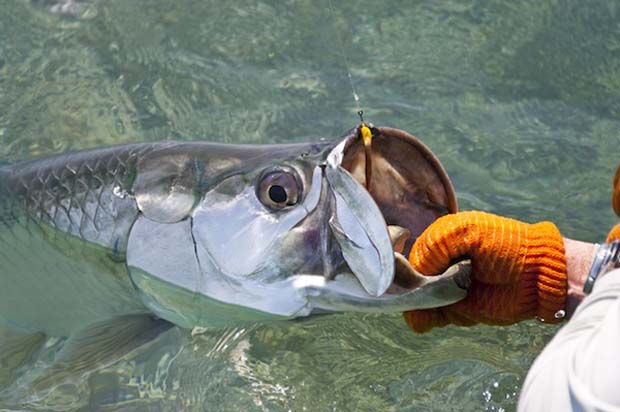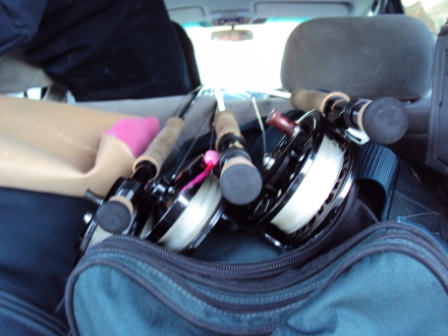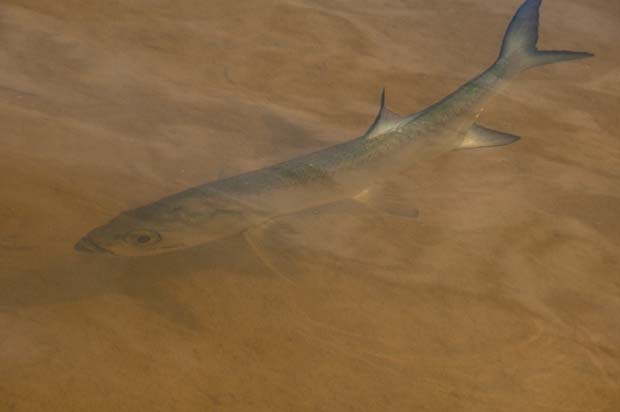By David Olson, managing partner of The Fly Shop of Miami
[dropcap]F[/dropcap]ew things cause as much anticipation for South Florida, Gulf Coast and the Florida Keys anglers as tarpon season. Fishermen, tarpon fishermen in particular, have been described as suffering from a dementia called “Tarponomic Threshold Intolerance:” An obsession to pursue megalops Atlanticus regardless of the residuum to one’s checking account, vocation or marriage. I even knew an angler who insisted that his daughter schedule her marriage outside of tarpon season!Rods
For you fly fisherman thinking of taking on the megalops, you should be forewarned that they’ll put a tremendous strain on your equipment, so having and maintaining the right gear is imperative. Rods in weights 10 to 12 are normally used, with 12-weights being the most popular. However, many tarpon anglers prefer an 11-weight because being a little lighter, it makes for gentler presentations.
Ten weights are generally reserved for calm days, smaller flies and anglers who know how to fight the larger specimens. The best way to approach getting ready, as that relates to choosing a rod, is to find a rod that you can cast accurately and quickly, and that has enough backbone to beat these powerful fish quickly.
Reels
Reels should be large enough to handle the appropriate sized fly line and 200- to 300-yards of 30-pound Dacron backing. The drag has to be smooth, strong and reliable. Buying a cheap, made in China big animal reel is like buying a pair of Converse sneakers for long hike in the snow – you’ll live to regret your profligacy. A large arbor design is preferable since it makes it much easier to take up line-quickly, which is always a plus with fast swimmers that frequently swim right at you. Much fishing for tarpon is done with floating fly lines. However, a floating line with a short, 9- to 10-feet of clear intermediate tip is also frequently used. A clear, full intermediate line will serve you well for dredging up fish around channels in the back-country.
Leaders, Tippets and Flies
Leaders range in length from 9-feet during windy conditions, to 15-feet or more when the air is still. Class tippets of 16- to 20-pound test are normally used in conjunction with shock tippets of 40- to 80-pounds. Effective fly pattern are too numerous to mention here – books have been written on that subject and the subject can cause bar brawls, but over the years, flies for ocean going tarpon have gotten smaller and smaller. Today, anglers like Andy Mill use 1/0 and many experienced anglers are even using smaller hooks when the tarpon get finicky.
Guides
If you are new to this “Tarponomic Threshold Intolerance” madness, it is good, solid advice that you hire a good guide. Tarpon fishing is best done with one angler fishing and someone skilled poling the boat. If you’re a new boat owner, and invite an angler friend and expect to pole each other to the promise land, beware, the learning curve is steep. Initiate yourself with a good guide. Think of hiring a good guide as the price of getting an advanced degree. An experienced guide will make you a better angler; faster. A top guide not only knows where they’ll be but understands the fishes behavior and body language, and he’ll coach you on spotting, where to put the fly and how best to tease the fish into eating the fly. The latter alone is worth the price of admission. I consider myself a very experienced angler, and I still find fishing with a good guide always teaches me something new and valuable, especially when it comes to tarpon fishing and even when the fishing was slow. A top guide will also coach you on properly fighting the fish, and how to land it – never think for a second that because the tarpon is a rod length from the boat that it’s game-over!
Unfortunately, the top guides are generally booked solid during tarpon season so it’s a wise man who plans ahead. Also, the top guides are not on work release so you’ll enjoy a day or week with someone who, like you, is really into it – you’ll profit from the experience and probably make a new friend.
It would be profligate not to have all your equipment in top shape. If your a little unsure about the condition of your equipment, or need some advice, go to your local fly shop and get professional advice. Stay away from big-box outdoor stores as they generally don’t staff their fly shop section with knowledgeable folks. You may end up with the wrong or improperly rigged gear.
You need to arrive at the ballpark ready to play – be prepared if your new at fly rod angling for tarpon – practice ahead of time. Learn to cast with the aforementioned heavier outfits. And you must know how to effectively double haul. Again if you’re new to the game, go to your local fly shop and ask for help, you’ll be glad you did.
A word of caution: Casting with a 12-weight can be tiring and in some cases it will cause “tennis elbow” if you just hit he field without practicing. Practicing for months ahead will build up the muscles and stamina. As a certified instructor, I advise folks to start with short, focused sessions and build from there. The most important play in your “reality” playbook will be being able to make medium length casts, accurately and quickly. Save the hero cast story for the office when you get back. Also, practice in the wind; tarpon are usually easier to feed under windy and choppier conditions.
Spending time learning to properly fight fish and apply pressure is also time well spent. With the aide of a friend and a handheld scale, apply pressure with the rod, exerting maximum pressure using the butt of the rod, not the upper portions. An effective way to get the feel for this is to point the rod tip at the scale with the fighting butt against your stomach, and with both hands, trap the flyline against the grip, raise your hands slightly while stepping back. This puts all the bend in the rear of the rod, as each step back increases the pressure applied. Once you have learned to pressure a fish, it is a good idea to tie up some class tippets and break them, gaining a feel for where the maximum pressure you can apply is. Also, learning to apply pressure at the correct angle, pulling across the back of a fish as he changes direction is essential to beating a fish quickly. Remember, the longer the fight is on, the more things that can go wrong. It’s best to fight them hard, take a few chances and you’ll beat them quickly. A fast battle is also much better for the fish – an overly tired fish are soon shark bait.
Finally, remember that this is supposed to be fun. You will certainly make some bad casts, miss some hook sets and break some fish off. But each cast and each fish is a learning experience, something to gain from. It may take a bit of time to land your first tarpon, but when you do, it will mean that much more to you.
[information]Guides sources: fishandflyonly, The Fly Shop of Miami, Florida Keys Outfitters, Angling Company, Saltwater Angler
[/information]







Join the discussion 4 Comments